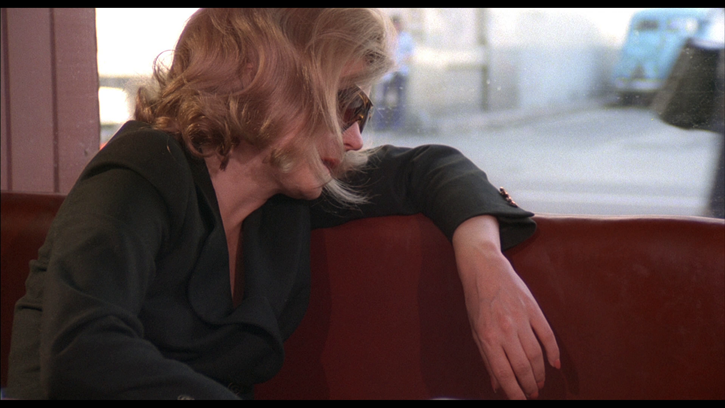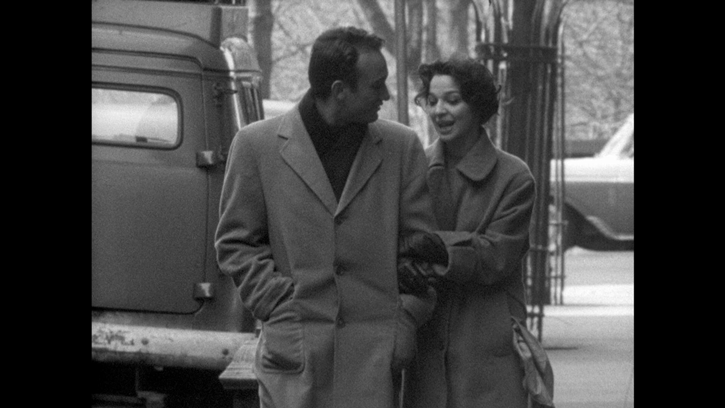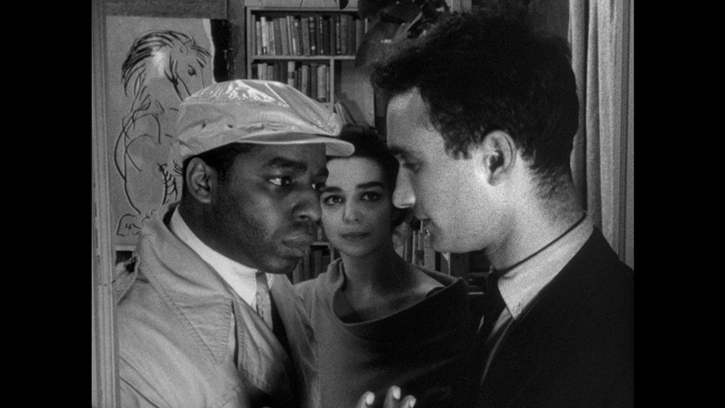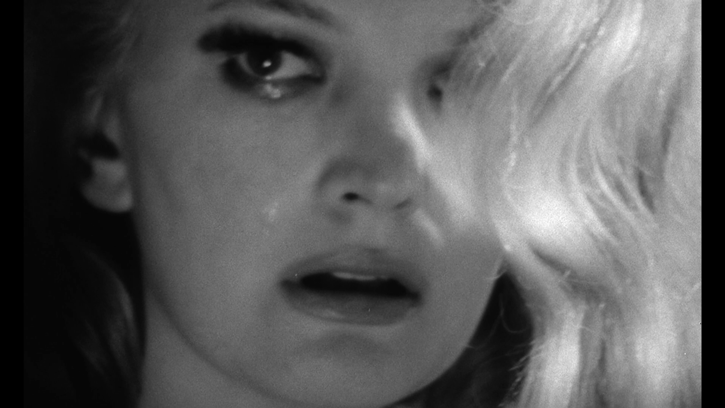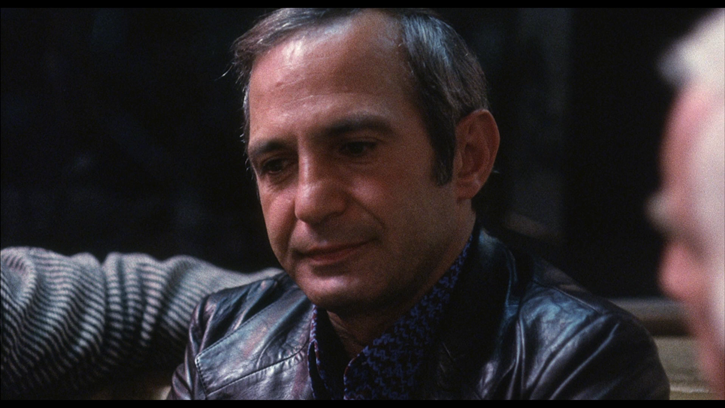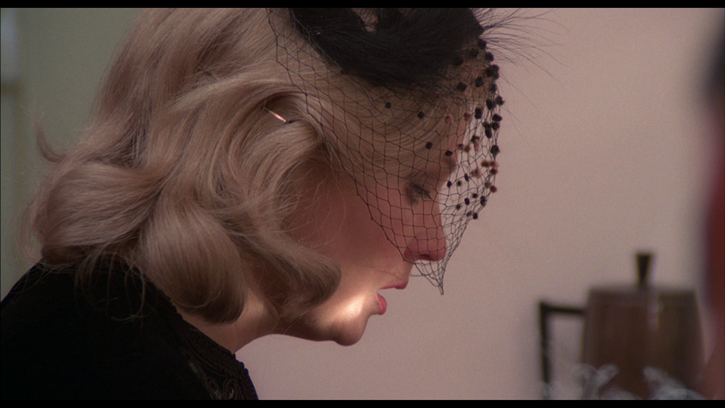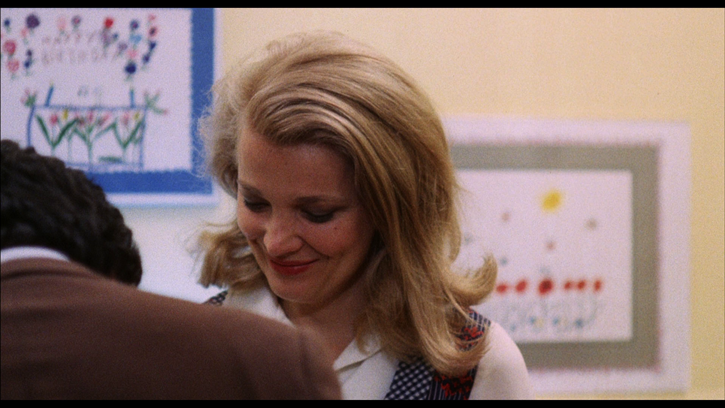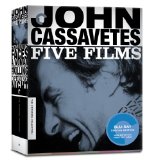| Reviews & Columns |
|
Reviews DVD TV on DVD Blu-ray 4K UHD International DVDs In Theaters Reviews by Studio Video Games Features Collector Series DVDs Easter Egg Database Interviews DVD Talk Radio Feature Articles Columns Anime Talk DVD Savant Horror DVDs The M.O.D. Squad Art House HD Talk Silent DVD
|
DVD Talk Forum |
|
|
| Resources |
|
DVD Price Search Customer Service #'s RCE Info Links |
|
Columns
|
|
|
John Cassavetes: Five Films
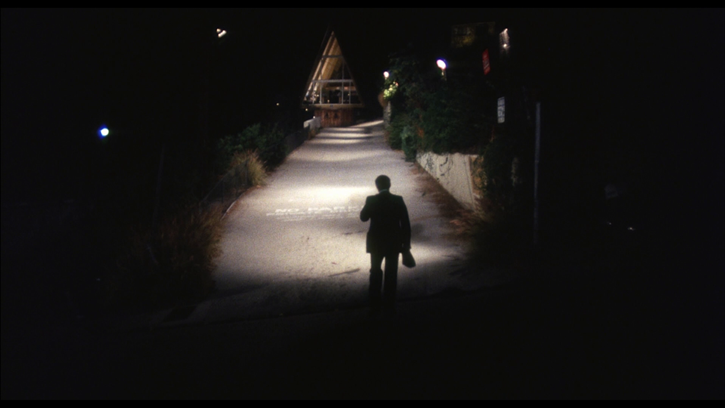
Screenshot from The Killing of a Chinese Bookie
Click on an image to view the Blu-ray screenshot with 1080p resolution
Criterion has released an upgraded collection of the films of iconic filmmaker John Cassavetes: now these works are available for the first time in High Definition on the Blu-ray format and massive filmmaking buffs can decide for themselves if Cassavetes is a master director or not with a collection containing five of his most noteworthy efforts: Shadows (1959), Faces (1968), A Woman Under The Influence (1974), The Killing of a Chinese Bookie (1976/1978, presented here in two versions - the original theatrical cut which lasted in theaters for less than one week and a shortened version with edits made to pacing), and Opening Night (1977), one of the last films to be made by Cassavetes. Actor, director, writer, and magician: Cassavetes made one of the biggest marks on independent cinema that the world has ever seen when he created stories as a filmmaker on a mission, along with his frequent collaborator, actress Gena Rowlands, whom he was married to until his passing in 1989.
If you have never seen a film by John Cassavetes before you might wonder why some films fans have become so enamored by his movies, though. The works of Cassavetes are often described as being the "truth" - as there is something about these films that manage to bring real acting, emotion, and stories to the cinema with fluidity. Or, the films are compared to slow European movies. In other words, the flavors of his films are not always readily enjoyed. Some say they are boring and tedious to watch; others consider the Cassavetes films to be some of the greatest achievements in the medium to date. Serious fans of cinema tend to debate his work but the inherent importance of these motion-pictures outweighs such debates.
Criterion understands that regardless of these opinions that the films are important works of filmmaking that shifted the landscape of independent cinema in America and helped inspire many filmmakers to go out and make movies, including the brilliant Martin Scorsese, who describes how viewing the works of Cassavetes was what made him decide he could be a filmmaker in the first place.
It's not that debatable that he was a founding father of independent American cinema. Cassavetes works are considered a starting point in early American independent cinema and to be examples of a true original director working outside of Hollywood's studio system. He would fund most films without outsides sources, and would put a lot of his own money into producing them. A distribution effort would require calling up theater owners personally and arranging for film prints to be distributed. The kind of intensely personal independent cinema creation that was scarcely seen prior to Cassavetes. With an undeniably original voice, his efforts were in the small pool of works that helped usher in a new kind of filmmaker that emerged in America. Cassavetes disliked Hollywood movies and the way the studios worked so it worked to be creative without the industry: to tell his stories the way he wanted to and without a guide suggesting changes and emitting from studio interferences.
Not everything from Hollywood is lacking in dramatic weight, of course: there are exceptions to be found, even from some of Hollywood's elite, such as the brilliant Steven Spielberg, who puts a personal stamp on his projects. If there were no great Hollywood filmmakers I would not be a professed lover of studio films, where filmmaking can sometimes take on even bigger scopes of scale with better budgets, production crews, and other positives that are impossible without the Hollywood producing system to support the visionary artists working within studios. Yet it is also a system where independent voices making movies like Cassavetes are in most cases overlooked. Many studios would simply ask themselves "But how can you sell a Cassavetes film?"
Within Hollywood, there are films that are made that seem created and oriented towards selling tickets to everyone with a disregard of individualism in cinema creation. There's often so much focus on what works the greatest for as broad an audience as possible. Sometimes, this leads to films being made that in fact will appeal a bit more to everyone buying movie-tickets, prior to seeing a motion-picture (once the marketing has gotten people into movie seats) but more and more viewers may walk away from their experience feeling disappointment.
This concept might seem acceptable to some as it brings in revenue, because at least tickets sold and profit is made. But when filmmaking is limited in scope and vision due to test audiences, third-party marketing, and other creatively limiting elements, it does not truly offer any real favors for the film industry and it's filmmakers. It's the sort of thing that leads to limited creativity. These are the sorts of issues Cassavetes seemed to have with the system.
Cassavetes is so divisive as a filmmaker (the 'love it' or 'hate it' kind of director - the kind of artist who polarizes audiences) that whether or not someone appreciates his work with cinema it's always something personal, reflective, and demonstrative of the sheer diversity of audiences and filmmakers. You have to be patient with his films and allow them to sink in. The stories also focus intently upon the actors and demonstrating their skills. This is something prominent within each effort, which seems most focused on bringing the best performances to the screen - more so than story or technical qualities such as sweeping camera vistas or specific editing techniques the filmmaking world often utilizes in conveying a mood or emotion.
There is a question that is always lingering after viewing his films: one wonders about what scenes or moments were scripted and what parts came from improvisation or on-the-fly creativity, as this was one element that was perhaps given more consideration from critics than anything else when considering these films. So much of his films were made scripted but many elements were known to be improvised out of basic ideas within scenes. Thus, sometimes one can even tell that the actors in a sequence are playing off of one another with an idea of what should happen with the scripted material, but without a guiding light to the destination. This spontaneity causes moments of brilliance and also some moments where, while authentically rendered, things may feel out of place to those unaccustomed to the style. Which should be almost everyone because this approach to cinema is uncommon and undeniably distinctive.
The only other filmmaker I would compare Cassavetes to is Jean-Luc Godard, who made wildly different films in style and tone but they both had the same creative disregard for having to follow filmmaking "rules" of structure, story, performance, and just about everything else which went into making their films unique and unlike the other films of the time. The similarity lies in the approach they gave to making movies, and it 's clear that both directors utilized some commonfree spirit duality that helped them to create the art they made with each cinematic outing.
Once one steps aside from considering the process in which Cassavetes produced and distributed his indie films, one can simply consider the films themselves for what they are: each of the films in this set is a well-directed and fascinating character study or a bold statement of some sort: the kind of elements that are worthy of exploration for film buffs and students alike. These ideas of how to tell stories and what to focus on was a large element of each picture.
In Shadows, the most improvisational out of Cassavetes films, the story centers upon Lelia (Lelia Goldoni), a light-skinned black woman who becomes romantically involved with Tony (Anthony Ray), a white man, who is unaware of her racial heritage. Upon realizing that she is African American and upon meeting her brothers, the story heads down some unexpected paths. The film was made with non-professional actors and it was filmed twice. Originally made with more technical elements thrown into the mix, Cassavetes decided that utilizing those elements of filmmaking took away from the film and it became a streamlined character study, transforming out of something primarily concerned with technical aspects into the type of film of his later works. I became mesmerized by the way the characters interacted: the dialogue flow seemed to be so natural, and when there are moments where the focus is simply on people eating together, or simply chatting with no real story connection, it becomes clear how unique it is in moving cinema towards a free-flow style that is reminiscent of jazz improvisaton. It seems rather fitting that this would be an element of the film as there is a jazz component to some of the characters, and indeed the beautiful music accompanying it fits the genre.
In Faces, the ultra low-budget 16 mm production, Cassavetes filmed his portrait of the "faces" people have with beautiful black-and-white photography that is as mesmerizing as everything else. The concept of the film exists where the focus is on looking at the sorts of people who are in conflict with the ideas of each other: it's really a modern approach to the feeling of alienation and misunderstanding that people sometimes feel, where the characters in the storyline seem so unaware of each other and what they want in life. The film takes the audience on a strange and unexpected trip alongside these characters, and there are many frames where the filmmaking is something that feels more like a "documentary" than what one would expect from the narrative.
A Woman Under the Influence is arguably the most famous film in the entire collection. In it, a brilliant performance by Gena Rowlands (which earned her an Academy Award nomination) is given as a woman dealing with mental illness. The film shows us her fragile state while it also is something demonstrating her kindness in nature and loving attitude towards others, including her children. On the other side of the spectrum, her husband, performed by Peter Falk, helps send her away to be committed until she is ready to come home.
The film has remarkable performances. I was most perplexed by the acting. It might not be the interpretation everyone will have, but for myself the film made me consider Rowlands to be a more sane individual than anyone else in the movie, despite a mental illness causing problems for her in her life. Her husband doesn't understand her or even seem to try and understand her illness and how this affects her life personally. The relationship between these characters is a unstable one that dramatically unfolds in a compelling way, but it is certainly not a story of a romantic couple, though it is a movie about love at the same time (or lack of love, as well).
I wondered about the Falk character, who after sending away his wife gives all of his children sips of alcohol, which causes them to cross their yard in a drunken display showing a loss of control, before he puts them to sleep. He seems to have no idea how to raise his children and there aren't any scenes really showing him doing things as a properly caring father. This is a stark contrast to Rowlands character, who takes good care of their children despite her illness getting in the way - she picks them up from school and shows them good love, attention, and care: and is only shown crossing a barrier when she has costumes for kids, both her own and a friends), because she is someone who seems to take care of the kids while her husband spends his time at work: working over-time and not providing the family with enough attention. Thus when Falk's character is faced with being there for his children when their loving mother was sent away and is now absent, he turns to giving them alcohol, as if this is his only idea of how these kids could possibly be consoled. If you can't tell yet, I consider Falk's character to be the most unlikeable one in this film.
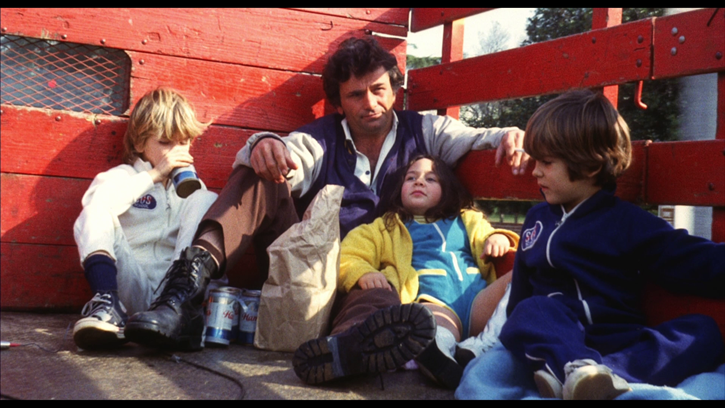
Screenshot from A Woman Under the Influence
When Rowland's character returns home, he sends away the people who came there to support her feeling it's a example of "too much" and upon a small dinner where she is being herself he says to her with ease "Just be yourself", as if she wasn't being exactly that in the first place. A Woman Under The Influence shows the relationship issues between this couple and examines their characters in a unique way. It is a genuinely fascinating character-study.
The Killing of a Chinese Bookie may be the most over-looked film in the collection. When the film debuted in theaters, audiences responded with little enthusiasm and it wasn't a long run at all with less than a week of showings before it was removed from theaters. Cassavetes reportedly was not pleased with the short time spent on editing the film prior to its release, and it's reaction seemed to be something that caused a reflection on the editing process for the film. Upon reflecting on its release, the film was eventually re-edited before finding re-release in 1778 in a version almost thirty minutes shorter in run-time. This version is significantly better for its edits. Everything about the film is improved by the shorter version cuts, which present what is essentially the same film, only a better paced version that cuts off some of the "excess" of the picture that was limiting it before. This includes removing a lengthy opening that seems to meander on and doesn't advance the storyline, which is problematic when one considers how long the story actually takes to enter the film even in the shortened cut. It also removes the introduction of the gangster characters - who become introduced later on a result - and which causes the film to have some added tension it would have lacked otherwise.
The story of The Killing of a Chinese Bookie focuses on a gentleman's club owner named Cosmo Vitelli (Ben Gazzara), who seems generally gentle in nature despite having his excess affections, including a obsession with the gambling world, where he has ranked up a debt of over $20,000 (in 1970's dollars) loaned by gangster-types who serve as the loan sharks of this story. Upon the gang seeking to collect upon his debt it becomes clear to Cosmo that he won't have an easy way of repaying them the money. Simply put, he has no money to do so. He becomes propositioned with a possible repayment being made by killing a "Chinese bookie" as they call their target. Unexpectedly, Cosmo winds up trying to kill the "bookie" but doesn't realize that the target is really someone far more dangerous than expected. It's another winning character study and a brilliant performance by Gazzara, especially in its 108 minute version, which is my preferred cut of the film and the version to view first.
Opening Night is about the strange events that occur both on and off stage while work is done through rehearsal for the latest play of a Broadway star, Myrtle Gordon (Gena Rowlands), an aging performer, who at every turn is feeling chaos of wondering if the work is good enough: wondering about the performance, the play, and everything that makes up the world of acting she's become so familiar with. After the death of a devoted young fan that Myrtle sees after a show, she begins to unravel with the show and changes things dramatically. The rehearsals of this play become much more complicated. And all the white, it turns into a question: What did happen to the fan? Was she a real person: Is it real or imaginary? The other individuals around her seem to care little and tell her to go on, but she is going through a crisis of creativity and it dramatically impacts everything, including (of course) her on-stage performance.
The concepts explored in this film are fascinating ones, as is the performance by Rowlands. I found the film to be a unique rumination on life, death, and aging and for those reasons it has some interesting elements. However, I found this to be the weakest film structurally in the set and I ended up caring very little about it. It seems to blend abstract metaphors and fantasy with reality in an odd way that is unlike the other films made by Cassavetes.
I was also astonished by the over-the-top theatrical scenes, and not in a good way, as they were frequently unfunny but played for laughs and met with a laughing audience consisting of extras (uninstructed on how to respond to the material), who seemed to enjoy the supposed "comedic hijinks" even though the play material itself made little sense when considered on its own as it was all out of context. One might wonder what the full play might have actually been like if it had been completely included within the story of the film. Alas, it was not to be.
On the whole, while I had some varying opinions about each of these films, I appreciated them for their artistic distinction and the ambition that went into making each film. The only one that wasn't particularly in synch with my taste in cinema was Opening Night, which seemed a bit too rambling, overcooked, and metaphorical for what it was trying to say about life, aging, and art. The filmmaking is so unique that there really is nothing else out there quite like a Cassavetes production and most of the films contained in this set are genuine classics, especially the Academy Award nominated A Woman Under the Influence and the under-rated 108 min. rerelease of The Killing of a Chinese Bookie. There is a lot of great work contained in this astonishingly compiled Five Films collection, and film fans who have any appreciation for independent cinema should explore this noteworthy and in-depth set.
The Blu-ray:
Video:
Criterion's Blu-ray upgrade to the John Cassavetes: Five Films collection is a fine improvement, presenting the films for the first time in High Definition. Each film in the set received a digital restoration, utilizing the best available source materials to create the restorations. Every film in the set was transferred from 35 mm masters (Faces being the lone exception as a 16 mm film - this effort came from a duplicated negative that was enhanced to a blown-up 35 mm source).
Film buffs will not be disappointed by the work done by Criterion and by the UCLA Film & Television Archive, as each film in the set was given a noteworthy transfer. The bit-rates on every feature impress, with only The Killing of a Chinese Bookie being slightly less notable because of the two versions of the film having separate presentations on the same disc. It's a barely notable difference as the slightly lower bit-rates on The Killing of a Chinese Bookie weren't dramatic enough to notice a drop in quality: the transfers were exceptional quality.
Purists will be happy to see film grain and no DNR on these transfers. Other annoyances (aliasing, edge enhancement) are not present. The image quality is crisp and color is well saturated and accurate. Occasional print damage is noticeable, particularly on Shadows. However minor it is, the good news is that there is nothing I would consider distracting. Dramatic improvements were clearly made in bringing the films to high definition as I sometimes found myself forgetting I was even watching Blu-ray discs - the experience essentially reminded me as if I was looking at actual film prints - that's how good the presentations are on this set. I am confident fans of these films will be most pleased.
Each film in the set is also presented in their respective original aspect ratios. Shadows is 1.33:1, Faces is 1.66:1. A Woman Under the Influence, The Killing of a Chinese Bookie, and Opening Night are 1.85:1.
Audio:
Each film in the set is presented with a lossless mono audio presentation preserving the original sound designs with 24 bit audio. The clarity and crispness of the audio is superb with excellent dialouge reproduction. The music utilized in these films also sounds superb and enhances the atmosphere of the films more effectively with these high resolution presentations.
Extras:
Criterion has once again provided an excellent supplemental package. This set contains a plethora of bonus materials relevant to each film in the collection. Here is a breakdown:
One of the most enjoyable and informative supplements from this collection is found with a 80 page booklet featuring essays written by Kent Jones, Gary Giddins, Stuart Klawans, and more. There is an abundance of writing by Cassavetes as well as interviews featuring him discussing his films and work process. Expanding further, the booklet has a number of tributes, including one by director Martin Scorsese and actor/writer Elaine Kagan. Readers who are curious about learning more about the filmmaker (both from himself and by some who have been impacted by his work) will find a lot of great material in this book. For an average reader, it's an abundance of material worth exploring. (I spent an entire evening reading the booklet from beginning to end - I was amazed by the depth of the material and I highly suggest it is read by all fans of these films).
On disc supplements include a mammoth documentary entitled A Constant Forge: The Life and Art of John Cassavetes (2000), a 200 minute document created by director Charles Kiselyak, who provides information about the filmmaker's process to making films and interviews of noteworthy inclusion with close friends and family to the filmmaker. This documentary is featured on the Shadows release disc.
Shadows also includes: Interviews with actor Lelia Goldoni and associate producer Seymour Cassel from 2004, Silent footage from the Cassavetes-Lane Drama Workshop, from which Shadows emerged, a restoration demonstration, stills, poster galleries, and the trailer.
Faces includes: an alternate 18 minute long opening sequence viewable separately, an episode of the French television series Cineastes de notre temps from 1968, which was dedicated to John Cassavetes.Making of 'Faces', a 2004 documentary featuring interviews with actors Seymour Cassel, Lynn Carlin, Gena Rowlands, and director of photography Al Ruban; Al Ruban on Lighting and Shooting Faces, which is a new program featuring commentary by Ruban.
A Woman Under the Influence includes audio commentary by sound recordist and composer Bo Hardwood and camera operator Mike Ferris, a conversation between actor Gena Rowlands and Peter Falk from 2004, an audio interview with director Joh Cassavetes from 1975, stills gallery, and a trailer.
The Killing of a Chinese Bookie includes both versions of the film, an interview program from 2004 featuring actor Ben Gazzara and producer Al Ruban, an audio interview with Cassavetes from the 1970's, a stills gallery, and the trailer.
Opening Night includes a conversation between actors Gena Rowlands and Ben Gazzara from 2004, an interview with producer and director of photography Al Ruban from 2004, an audio interview with director John Cassavetes from the 1970's, and trailers for the film.
Final Thoughts:
John Cassavetes: Five Films is another excellent set of films released by the Criterion Collection in a Blu-ray package. This set seems custom-tailored for film enthusiasts. The films themselves are divisive for audiences and won't appeal to everyone. Newcomers are encouraged to sample some of the director's works prior to exploring the entirety of the box-set release but longtime fans and anyone who considers themselves a Criterion devotee will be quite pleased with this elaborate collection of films from one of America's first independent filmmakers. The set is absolutely worth adding to a Blu-ray collection, and it features excellent PQ/AQ and some wonderful supplements that make this set an essential release for cinema devotees.
DVDTalk Collector Series.
Neil Lumbard is a lifelong fan of cinema. He aspires to make movies and has written two screenplays on spec. He loves writing, and currently does in Texas.
|
| Popular Reviews |
| Sponsored Links |
|
|
| Sponsored Links |
|
|
| Release List | Reviews | Shop | Newsletter | Forum | DVD Giveaways | Blu-Ray | Advertise |
|
Copyright 2024 DVDTalk.com All Rights Reserved. Legal Info, Privacy Policy, Terms of Use,
Manage Preferences,
Your Privacy Choices | |||||||









